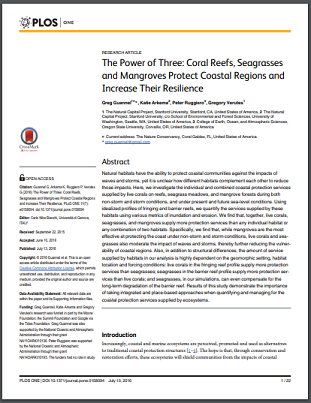
Natural habitats have the ability to protect coastal communities against the impacts of waves and storms, yet it is unclear how different habitats complement each other to reduce those impacts. Here, we investigate the individual and combined coastal protection services supplied by live corals on reefs, seagrass meadows, and mangrove forests during both non-storm and storm conditions, and under present and future sea-level conditions. Using idealized profiles of fringing and barrier reefs, we quantify the services supplied by these habitats using various metrics of inundation and erosion. We find that, together, live corals, seagrasses, and mangroves supply more protection services than any individual habitat or any combination of two habitats. Specifically, we find that, while mangroves are the most effective at protecting the coast under non-storm and storm conditions, live corals and seagrasses also moderate the impact of waves and storms, thereby further reducing the vulnerability of coastal regions. Also, in addition to structural differences, the amount of service supplied by habitats in our analysis is highly dependent on the geomorphic setting, habitat location and forcing conditions: live corals in the fringing reef profile supply more protection services than seagrasses; seagrasses in the barrier reef profile supply more protection services than live corals; and seagrasses, in our simulations, can even compensate for the long-term degradation of the barrier reef. Results of this study demonstrate the importance of taking integrated and place-based approaches when quantifying and managing for the coastal protection services supplied by ecosystems.












